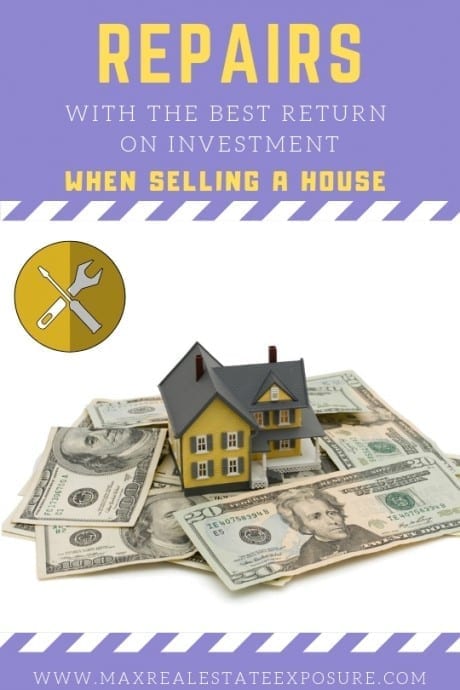What Renovations Should I Make at My House Before Selling?
 Are you wondering about the best renovations for ROI and resale? If so, you are wise to do so. Many potential homeowners never give it a second thought.
Are you wondering about the best renovations for ROI and resale? If so, you are wise to do so. Many potential homeowners never give it a second thought.
Many sellers assume that any renovations or repairs they do to their house will automatically increase the money they get for the home.
Unfortunately, this assumption can upset those who invest a lot of money in home improvements and find they don’t make their money back when they sell.
There are home improvements that increase value and those that don’t.
Before doing any remodeling project, it’s crucial to consider its potential impact on your home’s resale value.
Some savvy home sellers will ask a local real estate professional for advice before investing.
As a real estate agent for nearly forty years, one of the things I have constantly advised home sellers on is renovations that offer an excellent ROI and make resale easier.
My clients gain years of knowledge from knowing what works best. Unfortunately, sometimes, potential clients have already made improvements that won’t be worth their initial investment. Some are outright mistakes. Knowing what not to fix is as vital as what to improve.
This highlights the importance of always consulting with a real estate professional before making drastic changes to your property. Those that do will be in a much better position to put money in their pocket.
Some home improvements are apparent winners with high ROI. It is harder to know if other fixes will yield positive returns. Some home renovations are almost guaranteed to cause frustration because they rarely result in a higher sales price.
Some repairs are essential before selling, even though they may not have the highest return on investment. Why? They help the home sell!
Presale Inspections Are Wise
Some necessary repairs can prevent a house from selling. Depending on the age and condition of your home, you might want to consider getting it inspected before the sale. This way, you cannot only figure out beforehand if there will be any surprises, but you can also address them!
The inspection will help remedy the necessary repairs, and you’ll also be prepared for the buyer’s home inspection. Nobody wants to return their house to the market due to an inadequate inspection.
The key to picking which repairs is knowing what buyers consider essential—which may not necessarily be the same things you think are important.
One of the biggest errors sellers make is thinking that the repairs they want will be the same that buyers want.
Fortunately, you are doing your research now—before you spend much money on repairs. Read on to learn what repairs yield a solid return on investment.
Factors that Can Affect the Value of Home Repairs and Renovations
Before digging deeper into which home renovations offer good ROI, it is essential to know that various factors must be considered individually—things that may affect your home and repair ROI specifically.
These include the following:
- When you sell: The time of year you list your home may affect how much you get for your money with specific home improvements and renovations.
- How the market is doing: A buyer’s market differs from a seller’s market for many reasons. The effect of inevitable renovations on your home’s sale value is something that the state of the market will affect.
- Where your home is located: Buyers value some improvements differently depending on where the house is sold. For instance, a wood-burning stove might be more desirable in Massachusetts than in Miami. You’ll want to avoid mistakes when renovating a home.
- The competition you face when selling: The homes being sold in an area similar to yours always influence the price of your home. The inventory you are competing against will also affect the value buyers place on your home renovations.
Getting a Good Return on Investment—Home Renovations Worth Considering
When selling, making the best investments to increase home value is wise. Not only will you sell faster, but you’ll likely sell for more money. Let’s examine the best renovations to do before selling.
1. Refinishing Hardwood Floors and Pulling Up Carpets.
 There is no denying the appeal of hardwood flooring in today’s market.
There is no denying the appeal of hardwood flooring in today’s market.
Buyers appreciate the look and the convenience of hardwood flooring and are willing to pay for it.
The most cost-effective option for you as the seller is to pull up carpeting from existing hardwood flooring—if you have hardwood flooring underneath your carpets.
Getting hardwood floors refinished is short money compared to what it brings for a return on investment.
Even if you don’t refinish the floors, just pulling up the carpets and showing buyers you have hardwood can make a difference.
In real estate sales, first impressions are everything; it is one of the top improvements you can make for ROI.
Some buyers have no vision. You can tell them hardwood floors are under the carpet, but it means nothing if they can’t see it.
If you don’t have hardwood, you will need to consider if installing new hardwood or something similar—like engineered hardwood flooring—would be worth your sale.
Doing so is a question for your local real estate agent. Only they will know how much of an impact adding hardwood floors will make on your bottom line.
Preston Russ, Coastal Realty Info, helps many Florida homeowners spruce up their property before selling and highly recommends hardwood. Here is what he has to say:
“Swapping out carpet for hardwood floors is often seen as an investment to boost a home’s value and appeal to buyers. Hardwood floors are highly desirable due to their look, longevity, and low maintenance requirements.
Unlike carpets that wear out quickly and need replacement, cleaning, and stretching, hardwood floors can last for years and gain charm over time as they wear, becoming a unique feature that enhances the home’s character.
Additionally, hardwood floors can significantly improve the appearance of a room, creating a sense of spaciousness and unity. A rug can always be added to tie in décor themes and colors. This timeless appeal can make a property more attractive in the real estate market, potentially leading to sales and better offers.”
2. Making Entertainment Areas Into Hardwood or Something Similar.
If you add hardwood floors, the rooms where people spend a lot of time or tend to entertain others are the most popular areas with buyers.
For example, most people love seeing hardwood floors in the kitchen, family room, and formal dining room. Pulling up the carpeting in these areas and adding engineered hardwood flooring can be beneficial.
There are many engineered hardwood flooring options, and they can often be purchased for a reasonable price. You can also install them yourself if you are inclined—which would put even more money in your pocket on the day of sale.
3. Paint The Walls and Ceilings.
There is nothing more cost-effective in home sales than painting. A new coat of paint is one of the cheapest improvements you can make to your home to make it more appealing to buyers.
When buyers come to view your home, they are looking for things to complain about, and nothing is more straightforward to dislike than stains on the walls or ceilings. Stains and other imperfections stand out, making the home seem dirty even if it is spotless.
Water stains on ceilings are commonplace. Often, a child leaves a curtain partially open while taking a shower. Water stains, however, freak buyers out. Nobody wants to see water stains. The fear is that the stain is not old but an active leak.
Sometimes, it is not uncommon to see a water stain from an old ice dam problem in cold weather climates. Whatever the case, it is crucial to remove old water stains.
4. Remove Dated Wallpaper and Popcorn Ceilings
Removing items that potential home buyers can’t stand is always an excellent decision when trying to improve ROI and resale potential.
Two such items are wallpaper and popcorn ceilings. Both date a house.
They are neither appealing nor attractive to the majority of buyers. Removing these items will increase your chances of a quicker and more profitable sale.
Add a fresh coat of paint to the walls, remove wallpaper, and paint the wood paneling. No one wants to buy a home with old wallpaper, and finding a buyer who finds wood paneling appealing is hard.
Painting ceilings is a little more challenging than painting the walls, but it completes the look and ensures everything looks nice and clean. If you have a popcorn ceiling, you should consider removing them.
You can look at my guide on removing wallpaper and the steps for getting rid of a popcorn ceiling. Both can be done as DIY projects, but I recommend hiring professionals, especially for popcorn ceilings.
The result will be locking up a buyer who may have passed on your home otherwise.
Keep in mind that old popcorn ceilings may contain asbestos. Be extremely cautious when removing the old texture, or again, hire a qualified professional to do it safely. With newer popcorn texture, you can scrape it off. It is a long process but inexpensive and makes a big difference in how buyers see your home.
Removing wallpaper and popcorn ceilings when selling a house are both high return investments.Click To Tweet4. Be Strategic in How You Remodel the Kitchen.
 Strategic home improvements, particularly in the kitchen and bathroom, can dramatically increase a property’s marketability and appeal.
Strategic home improvements, particularly in the kitchen and bathroom, can dramatically increase a property’s marketability and appeal.
Understanding the ROI of home renovations, such as minor kitchen remodels, can position homeowners on where to invest their money wisely.
Kitchen remodels get your money back when you sell, so they are usually worth doing if the kitchen is dated. However, it is also easy to lose money if you are not careful with how you renovate.
Consider refinishing the cabinets if you can afford it. Replacing them will be expensive. It is challenging to get a return on investment by completely remodeling a kitchen, the most expensive room in the house to renovate.
You can easily spend tens of thousands of dollars on a moderate-sized kitchen.
Believe it or not, painting a dark, dated kitchen, however, can completely transform it into something special. If done correctly by a highly skilled painter, it can look like new.
Basic hardware like the sink and faucet can be replaced inexpensively, but avoid installing luxurious appliances because buyers may not pay for them.
Installing granite counters in most areas offers significant value and significantly impacts the house’s saleability.
Depending on the price range, buyers expect granite. Granite is a significant hot button in home sales, and the cost of adding granite counters has decreased in recent years.
5. Renovate The Bathroom if it Needs it.
Bathroom renovations also generate positive returns in most cases. A new coat of paint—lighter is better in small spaces—and new fixtures can all be done without too much expense.
HGTV has some excellent examples of remodeled bathrooms under five thousand dollars. Take a look to inspire some thoughts on what to do at your place.
If you cannot get stains from shower doors, tub, or sink, replace the doors and refinish the surfaces.
Joe Boylan, a veteran Realtor and owner of Springs Homes, recommends the following:
I can’t overstate the impact of a bathroom’s condition when selling a home. As an agent who works with many homebuyers, I’ve witnessed firsthand the difference an updated bathroom can make. While outdated bathrooms often lead to disappointment, modern renovations with amenities like steam showers, heated floors, and spa-like features turn houses into coveted homes. It’s not just about the aesthetics; it’s about the experience. An investment in a bathroom renovation is an investment in your home’s future marketability and buyer appeal.
I could not agree with Joe more. I see every day what an impact it can make on ROI and saleability.
6. Replace The Roof if it Needs to be Replaced.
If your roof needs to be replaced, taking care of it now will make the sales process more manageable. Just because the roof is old does not mean it has to be replaced soon, however. It is in your best interest to have a professional look at your roof and discuss the results with your realtor.
A professional roofer will be able to determine if replacement is necessary immediately or if you have a few years left. Generally, a nonarchitectural roof shingle will last around twenty years. Most architectural shingles will last anywhere from thirty to fifty years.
Buyers may be willing to purchase the home if the roof has two or three years left on it. If the roof needs to be replaced within a year or so, you will be better off having the work done before listing the home.
Unfortunately, roofs do not have a high return on investment when selling a house. When I counsel sellers, I usually tell them to do nothing with the roof. I’ll tell them to expect buyers to want a closing cost credit.
Most of the time, you will be far better off negotiating a credit than replacing the roof, given the cost and what you’ll get back.
7. Clean Up The Exterior of The Home.
 Your home’s exterior is the first thing buyers will see when they come to view your home.
Your home’s exterior is the first thing buyers will see when they come to view your home.
Enhancing the curb appeal with a new garage door can make a lasting first impression on potential buyers.
The little things you do to make the home look nicer at first glance are inexpensive for the most part and can be great for helping your home stand out.
According to Zonda Media, curb appeal is one of the best places to put your money for ROI.
Some of the exterior repairs that you can address may include patching cracks in the sidewalk and driveway, replacing the caulk around your windows, adding new fixtures like doorknobs, painting the front door, fixing broken fences and painting them, planting flowers, and adding mulch to flower beds.
Here is an excellent list of exterior home staging tips to spruce up your house.
Karen Highland of Frederick Real Estate Online provides some excellent advice for sellers.
“Creating good curb appeal for your home creates that all-important first impression for buyers. But, contrary to some advice you might get, I don’t think it needs to be expensive or complicated. Most of the time, all it takes is some elbow grease.
If you’ve been in your home for long, you probably have overgrown greenery or plantings past their prime. Pruning and cleaning up will go a long way in tidying your landscape. A layer of fresh mulch works like magic!
Other simple tasks might include power washing your entry paths and exterior surfaces. Windows and gutters should be clean. Often, a good coat of paint on your front door or window shutters will be the perfect refresher for the front of your home.
Don’t overlook any minor repairs, like spots of rotting wood trim or damaged siding. The simple goal is to ensure that your home’s exterior looks well-maintained. This will set the proper impression for the rest of your home.
8. Additional Exterior High Return Investments: Siding and Decks
When considering renovations to boost your home’s resale value, it’s essential to look beyond the interior and consider exterior improvements that can significantly enhance curb appeal and functionality. Two such projects include:
- Deck Addition: As a homeowner in multiple states, I have always enjoyed having a nice deck area. A deck extends your living space and offers an appealing feature for potential buyers. Most buyers I have worked with want the appeal of outdoor living space. According to industry experts, adding a deck can yield a return on investment of up to 75%. It makes it a worthwhile consideration for homeowners looking to sell.
- Siding Replacement: Replacing old or worn siding can dramatically improve your home’s appearance and curb appeal. Options like fiber-cement and vinyl siding offer durability and a fresh look that can attract buyers. With an ROI of up to 94.7% for vinyl siding, this renovation is a smart choice for those who want to enhance their home’s market value.
Incorporating these renovations can make your home more attractive to potential buyers and offer a solid return on your investment.
8. Anything That Prevents a Buyer From Getting a Mortgage
Real Estate values are significantly influenced by supply and demand. Homes in high demand will command more than those that are avoided. If your home cannot be financed due to its condition, you’ll eliminate a significant part of the buyer pool.
While conventional loans do not have strict condition policies, other popular mortgage programs do. Both FHA and VA loans have minimum condition requirements that must be met.
When selling, if your home does not meet them, a buyer will not be able to make a purchase.
Eric Jeanette from FHA Lenders has provided insight on how this may impact a buyer’s ability to purchase the home:
Bill, the property requirements and inspection guidelines regarding FHA loans are very strict. Changes to the house must conform to FHA property requirements for 1-4 unit primary residences. Inspectors will also look at safety.
For example, if you add a deck, it must have a railing and be built to code. Any other improvements may not result in unsafe conditions for the new buyer, and those conditions will likely surface during the inspection and could result in a failing inspection.
You can see the condition requirements for FHA loans here.
Luke Skar of Madison Mortgage Guys explains that VA loans have condition requirements similar to FHA loans.
Bill, borrowers should know going into a purchase that homes utilizing VA financing must meet minimum requirements for safety and livability. Buyers, sellers, and real estate agents can waste a significant amount of time when a property does not meet this minimum criteria. It makes sense for sellers to make the home improvements necessary for their property to pass the appraisal and inspection requirements.
I have also summarized the property condition requirements for VA loans.
8. Talk to Your Realtor Before Making Any Repairs or Renovations.
Your agent should be well-qualified to tell you what exactly you need to do to make your home more marketable. They know the market and have the insight necessary to help you make decisions.
What home improvements to make in a house can vary from one market to the next. This is one of the reasons people say all real estate is local.
Paul Sian, owner of Cincinnati and Northern Kentucky Real Estate, shared the following helpful advice for potential sellers:
“Chatting with a Realtor lets a homeowner learn what is hot in the local market. For example, a pool in Cincinnati, Ohio, will not have the best ROI due to only being usable 4-6 months a year (maybe more with a heater). That same pool in Texas or Florida could provide a great ROI. The local agent will know what buyers in their area are looking for and what buyers will actively avoid regarding over-improvements. A long-term relationship with a local realtor means having great inside knowledge that one can’t get from other sources.”
Repairs Without a High Return on Investment But Necessary
Some repairs are needed with a home that doesn’t bring a high rate of return. These are the items that buyers consider essential to functioning.
They are considered “normal” to be working upon transfer.
Buyers generally will not pay more money for these items. Some of them include:
- A functioning septic system if the sewer is not available. New septic systems have a meager return on investment.
- Smoke and carbon monoxide detectors in the house that function correctly. These items are vital to safety.
- Any existing significant structural or mechanical defect in the home. For example, if the heating system is failing, it would make sense to get it replaced.
- Any problem that would prevent a buyer from obtaining a mortgage. This is obvious: You will never sell your house for top dollar if you need a cash sale.
- If you don’t have public water and your house has a poorly functioning well, you should fix it before considering selling your home. Buyers expect excellent quality and quantity from their water supply.
- You know you have high radon levels in the water or the air. Nearly all buyers will want this corrected before proceeding.
- A significant electrical issue, especially if it is a fire hazard.
Sellers need to understand that while these improvements may not be a high-returning investment, they could be necessary to sell. Home sellers should also know the home renovations that don’t add value.
Conclusion
Understanding the top renovations and improvements for return on investment and resale value will put you in the best position as a seller. Before listing your property for sale, you should have a solid handle on what to consider.
About the Author: Bill Gassett, a nationally recognized leader in his field, has provided information on the best home renovations for ROI and resale. Bill has expertise in mortgages, financing, moving, home improvement, and general real estate.
Learn more about Bill Gassett and the publications in which he has been featured. Bill can be reached via email at billgassett@remaxexec.com or by phone at 508-625-0191. For the past 38+ years, Bill has helped people move in and out of Metrowest towns.
Are you thinking of selling your home? I am passionate about real estate and love sharing my marketing expertise!
I service Real Estate Sales in the following Metrowest MA towns: Ashland, Bellingham, Douglas, Framingham, Franklin, Grafton, Holliston, Hopkinton, Hopedale, Medway, Mendon, Milford, Millbury, Millville, Natick, Northborough, Northbridge, Shrewsbury, Southborough, Sutton, Wayland, Westborough, Whitinsville, Worcester, Upton, and Uxbridge Massachusetts.

